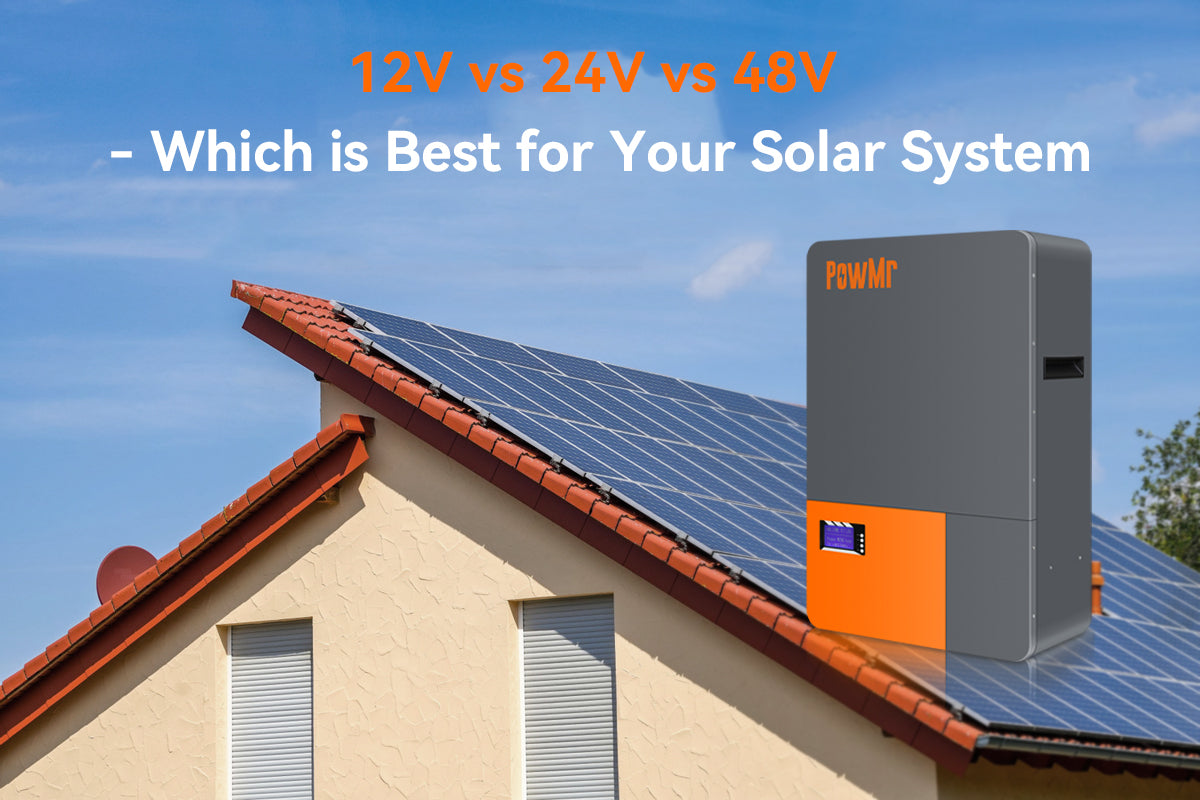Selecting the right voltage for your solar power system is a critical decision that significantly impacts its overall performance. Whether you are powering your home, an electric vehicle, or a commercial space, understanding the differences of 12V, 24V, and 48V configurations is essential. In this comprehensive guide, we will explore the factors influencing this decision.
Understanding Your Energy Needs and Loads
Before delving into the voltage discussion, it's crucial to understand your energy needs and loads. The energy demands of your electrical appliances and devices play a pivotal role in determining the design and capacity planning of your solar power system.
The voltage of a battery is a key factor in determining its energy storage capacity. The energy stored in a battery is calculated using the formula:
Energy (Wh) = Voltage (V) × Capacity (Ah)
Comparison of Energy Storage and Backup Time in 12V, 24V, and 48V Batteries
Given that three batteries have he same ampere-hour capacity of 200Ah but different voltages (12V, 24V, and 48V), let's compare their energy storage capacities:
-
For 12V Battery
Energy (Wh) = 12 V × 200 Ah = 2400 Wh -
24V Battery
Energy (Wh) = 24 V × 200 Ah = 4800 Wh -
48V Battery
Energy (Wh) = 48 V × 200 Ah = 9600 Wh
This means that for a similar load, a 200Ah battery with higher voltage will give longer the backup time.
Tips:
It's worth noting that you might consider connecting two 12V batteries in series to achieve a higher voltage. However, if you connect two 12V, 200Ah batteries in series, the output voltage will double, while the ampere-hour (Ah) capacity remains the same.
This way, you will obtain a 24V, 200Ah battery bank composed of two 12V, 200Ah batteries. Please read articles on the series and parallel connection of batteries for more information.
A thorough analysis of your loads ensures that your solar system is tailored to meet your specific requirements. For an in-depth guide on this, check out How Many Batteries for My Solar System and take inductive load into account.
Determining the Best Battery Voltage for Your System
The power transmission efficiency of an electrical system can be significantly improved by optimizing the voltage levels. According to the formula P = VI (Power = Voltage × Current), higher voltage enables the transmission of the same power with lower current, resulting in reduced energy losses and enhanced system efficiency.
Analysis of Currents in 12V, 24V, and 48V Batteries for Power Transmission
To illustrate this concept, let's compare three batteries: a 12V 200Ah battery, a 24V 200Ah battery and a 48V 200Ah battery. Assuming a total energy demand of 5000W, we can calculate the currents for each system using the formula:
Current =Power/Voltage
-
For 12V Battery
I=P/V = 5000W/12V ≈416.67A -
24V Battery
I=P/V = 5000W/24V ≈208.33A -
48V Battery
I=P/V = 5000W/48V ≈ 104.17A
This example clearly demonstrates that the 48V system transmits the same power with half the current compared to the 24V system. This not only minimizes resistive losses but also improves overall system performance. The higher voltage configuration proves to be more energy-efficient, showcasing the importance of voltage optimization in electrical systems.
Tips:
Considering a 24V system with a current demand of 208.33A, careful consideration of the discharge current of the battery becomes crucial.
Take, for instance, PowMr's 24V 200Ah battery, which has a discharge current of 100A, evidently insufficient to meet the current demand in the above case. To ensure safety and meet high current demands, it is imperative to implement a parallel connection of batteries.
PowMr's solution shines here – our 24V 200Ah battery supports parallel connections, allowing up to 15 batteries to work seamlessly together. This not only handles the current demand effectively but also ensures Battery Management System (BMS) compatibility. Choose PowMr for an efficient, reliable, and scalable power solution!
Is Higher Voltage Always Better for Solar Systems
While higher voltage offers advantages in terms of energy efficiency and reduced power losses in electrical systems, determining the optimal voltage for your solar system involves a careful balance of factors. The relationship between voltage and performance is nuanced, and it's essential to consider various aspects for a well-designed and cost-effective solar power setup.
To strike the right balance between performance and practicality, here is a common rule of thumb based on energy demand:
- If your energy requirement is less than 1500W,
a 12V configuration is generally considered sufficient and cost-effective. Ideal for applications such as RVs, electric vehicles and boats, where lower power demands are common. - For energy demand between 1500W and 5000W,
a 24V configuration is recommended for better performance and efficiency. Offers improved efficiency for medium-sized systems with moderate power requirements. - If your energy demand is greater than 5000W,
a 48V configuration is deemed the most beneficial in terms of cost, space utilization, and overall system efficiency. 48V systems provide enhanced efficiency and are well-suited for handling the increased power load in larger residential installations and comercial/industrial systems.
By aligning your voltage configuration with your energy demand, you can ensure that your solar system meets your specific requirements while optimizing cost and space utilization. Always conduct a thorough analysis of your solar array capacity to make informed decisions about the voltage levels in your solar power system.
Sizing Your Solar Panel Array
While solar panels have a nominal voltage, it refers to their "nominal voltage" rather than the actual generated voltage. In reality, solar panel operating voltage is usually higher than the acceptable voltage for batteries to compensate for transmission losses in wires and ensure efficient charging even on cloudy days. The solar charge controller is responsible for managing excess voltage to meet the battery's requirements.
Therefore, after determining the overall system's energy needs and battery voltage, ensuring compatibility of the solar charge controller with the battery and the solar panel array specifications is of paramount importance.
Tips:
Due to the different operating principles of PWM controllers and MPPT controllers, PWM charge controllers can only operate effectively on solar panels with voltage levels similar to their own. Therefore, if you are using a parallel solar array, we recommend using an MPPT solar charge controller. MPPT controllers have a significantly higher input voltage rating than the battery banks they charge.
Additionally, if you plan to expand your solar energy system and upgrade from a 12V system to a 24V/48V system to meet higher power output requirements, we also recommend using an MPPT controller.
Solar Charge Controller Voltage Matching
Solar Charge controllers play a crucial role in regulating energy flow and protecting the battery. It's imperative to understand how solar charge controller compatibility with both the battery and solar panel voltage is essential for optimal system performance.
After determining what type of solar charge controller to use, it is crucial to verify its compatibility with both the voltage and battery type of your battery bank. Currently, many solar charge controllers, like the PowMr M60 Pro 60A MPPT charge controller, which can utomatically detect battery systems of 12V/24V/36V/48V and is compatible with deep cycle sealed, gel, flooded, and lithium batteries.
To confirm the right size of the solar charge controller for your setup, you need to compare the specifications of the battery and charge controller as outlined in the parameter table. This ensures a seamless integration and optimal performance of your solar energy system.
Inverter Selection Strategies
To supply power to AC appliances, it's essential to connect a current inverter or hybrid inverter to the battery bank. Ensuring the voltage alignment between the battery bank and the inverter is critical. Put simply, for a 12V system, use a 12V inverter, and for a 48V system, opt for a 48V inverter.
Conclusion
In conclusion, the choice between each voltage configuration for your solar power setup involves a careful consideration of various factors. Let's summarize the key advantages and disadvantages of 12V, 24V, and 48V systems and provide a concise comparison table:
| Aspect | 12V System | 24V System | 48V System |
|---|---|---|---|
| Energy Efficiency | Lower | Better than 12V | Highest |
| Suitability for Size | Small systems (<1500W) | Medium systems (1500W-5000W) | Large systems (>5000W) |
| Initial Cost | Lower | Moderate | Higher |
| System Complexity | Simple | Moderate | Complex |
| Comparison based on constant energy demand | |||
| Current Requirements | Higher | Moderate | Lower |
| Backup Time | Less | Moderate | More |
In summary, selecting the right voltage is crucial for a solar power system that fits your needs, balancing efficiency and cost-effectiveness. Choose your solar system voltage wisely based on factors like array size, budget, and needs. Ensure compatibility among components for smooth integration. This ensures efficiency, cost-effectiveness, and future scalability. Thorough analysis and compatibility checks ensure optimal performance and integration.



